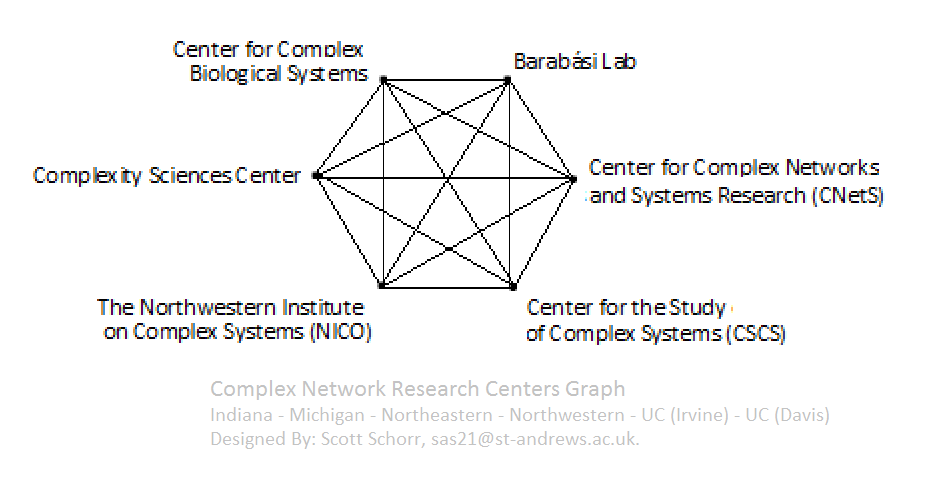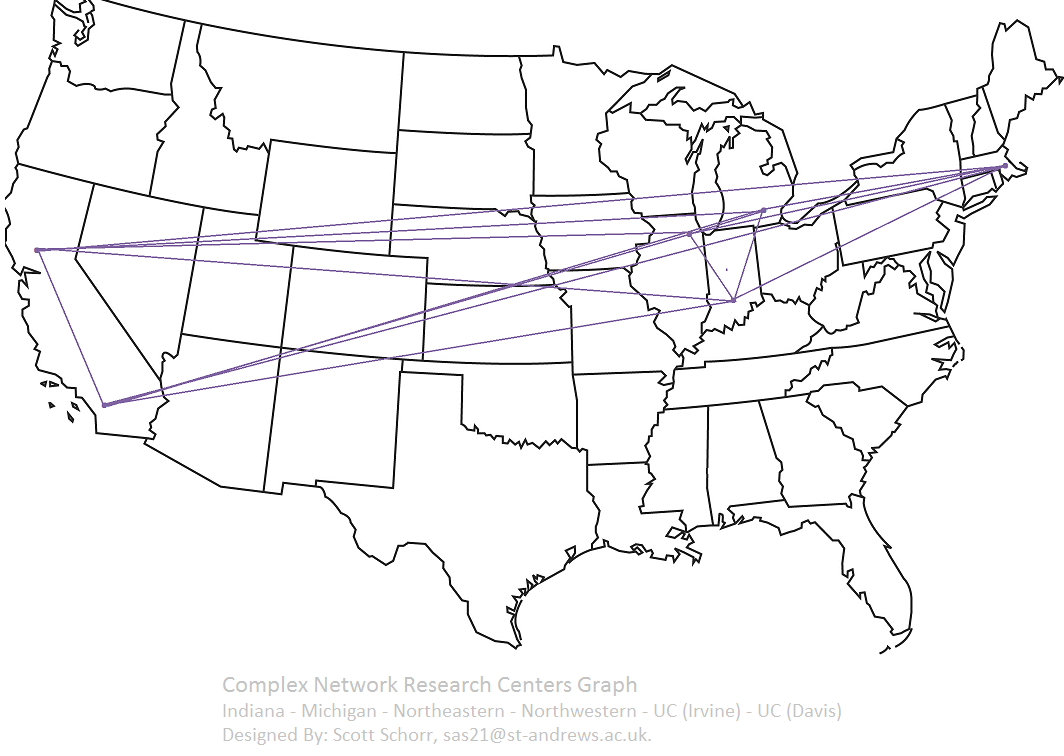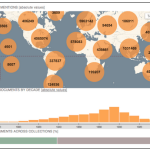Complex Networks for Complex Historians: Bridging Complexity Sciences and the Humanities
Abstract
In a journal article titled The Shape of the History of Science Profession, 2038: A Prospective Retrospective, historian of science Lynn K. Nyhart makes a bold prediction that future boundaries between disciplines in universities will manifest themselves differently in 2038. One new field she lists among many is Complexity Studies. To further define this new form of ‘consolidated department’ Nyhart lists some of its working disciplinary components, “Complexity Studies (encompassing physics, mathematics, and some parts of ecology, sociology, and computer science)”.[1] My main question is whether or not history may be included in this new field?
Historians’ use and mastery of language to communicate connectivity, flow, circulation, space, and entanglement may aid in offering other fields within Complexity Studies with much needed language to communicate concepts that operate on much larger or smaller scales (e.g. Quasar to Quark), and not always in a human language (e.g. programming, higher order logic). Likewise, historians may stand to gain from adopting methodologies within computer science, physics, and ecology to better analyze, spatialize, and visualize our own subjects of study. In my own case, I see frontiers in institutional and transnational history.
Three main goals for my presentation are to: (a) introduce complex network literature (e.g. Mark Newman, Albert-László Barabási, and Duncan Watts), (b) discuss the role of temporal scales with historical data sets, and (c) provide an example of software visualization and node-edge map making for historians. For the latter component, my presentation will include an original data visualization to display how Schools of Complexity Studies have already begun to institutionally appear with the rise of new university research centres during the first 14 years of the 21st century in response to complex network scholarship initiated in the 1990s. These Schools form a global network of scholars in traditionally diverse fields (i.e. transdisciplinary), linked via transnational connections and a common interest in offering new answers to old questions.
[1] Lynn K. Nyhart, ‘The Shape of the History of Science Profession, 2038: A Prospective Retrospective’, ISIS, Vol. 104, No. 1, March 2013. Online. http://www.jstor.org/stable/10.1086/669895
Curriculum Discussion
i) Should universities, and perhaps even secondary schools, be adapting their current curriculum or adopting a new curriculum to account for the developments and technological opportunities we can observe through our papers collectively?
ii) There are some crossovers with this type of study with physics, chemistry, and biology. Is it worth trying to have that discussion and exploration of these disciplines, or is it too niche? How is this related to current curricula in history?
iii) How would you label your research interests? It might be effective for us to coordinate between each other to communicate the methods we are studying (and what it should be/is called).
iv) How do we discuss visualization techniques with historians (who are not attending our conference) who either do not see the merit in this approach or conceptually don’t understand the computing element? The latter is no individual’s fault. As mentioned in previous questions, it is a result of past and current curriculum.
Visualizing Node-Edge Designs with an Engineering Mentality using Non-Programming Language
I am currently studying computer science, but I think one of the most useful exercises I have experienced in my time coding is to perhaps paradoxically remove the programming element. Computer science was built upon a foundation of Mathematics and Logic. Similar to Nyhart’s prediction regarding future Schools of Complexity Studies, many Schools of Computer Science have historical origins in Schools of Mathematics (including St Andrews). The demand for computing resulted in the creation of new Schools to study a piece of metal and plastic called a computer, and the manipulation of bits labeled 0 and 1 in complex algorithms called software. It really isn’t rocket science (although, it can be used by aerospace engineers). All of the software and languages you will learn about this week are built upon a foundational ‘stack’ of technologies, where the first ‘layer’ is 0s and 1s. The ‘magic’ happens when you can transform these 0s and 1s into maps and visualizations for your own research.
Complex Network Literature Sample
For a short reading list, I would recommend the following four texts, which are meant as examples for various levels of complex network literature.:
Beginner (note: Novel Style. Comfortable for Historians.)
- i) Barabási, Albert-László. Linked. http://www.barabasilab.com/LinkedBook/index.html
Intermediate (note: Textbook Style. Comfortable for Students.)
- ii) Newman, M.E.J. Networks: An Advanced Introduction. http://www-personal.umich.edu/~mejn/networks-an-introduction/
Advanced (note: Scholarly Journal Article Style. Comfortable for Research Contributors.)
- iii) Albert, Réka and Albert-László Barabási. “Statistical Mechanics of Complex Networks”. http://arxiv.org/pdf/cond-mat/0106096.pdf?origin=publication_detail
- Note: The Albert et. al article was chosen somewhat arbitrarily. First and foremost, to illustrate the journal and mathematical style of the advanced complex network scholarship, and also practically because it has a Google Scholar citation rate of 13778 (that is not a typo).
- iv) Watts, Duncan J. “The ‘New’ Science of Networks”. Annual Review of Sociology. http://www.jstor.org/stable/29737693?__redirected
- Note: The Watts article was chosen to show that physicists are not the only prominent complex network scholars, as Watts is a sociologist.
A comprehensive and updated list of complex network literature is available via the Barabási Lab. This is a good starting point: http://www.barabasilab.com/netlibrary.php .
Data Points for Visualization
Barabási Lab (Center for Complex Network Research (CCNR) – Northeastern University – Boston – 42°21′29″N 71°03′49″W – http://www.barabasilab.com/
Center for Complex Networks and Systems Research (CNetS) – Indiana University – Bloomington – 39°9′44″N 86°31′45″W – http://cnets.indiana.edu/
Center for the Study of Complex Systems (CSCS) – University of Michigan – Ann Arbor – 42°16′53″N 83°44′54″W -http://www.lsa.umich.edu/cscs
The Northwestern Institute on Complex Systems (NICO) – Northwestern University – Evanston – 42°02′47″N 87°41′41″W – http://www.nico.northwestern.edu/
Complexity Sciences Center – University of California at Davis – Davis – 38°33′14″N 121°44′17″W -http://csc.ucdavis.edu/Welcome.html
Center for Complex Biological Systems – University of California Irvine – Irvine – 33°41′3″N 117°47′33″W – http://ccbs.uci.edu/
Visualization Technique I – Complex Network Graph (node-edge model)
<!– –>
Visualization Technique II – Complex Network Graph (map visualization)
Fundamental Questions for Discussion (Subject of My Lightning Talk)
i) What is the purpose of the node-edge diagrams?
ii) What is the future format of scholarly research in this area: (i) individual researcher, (ii) single institution, multi-disciplinary team, (iii) multi-institution, single-disciplinary team, or (iv) multi-institution, multi-disciplinary team?
iii) Programming, how to educate historians? Should this be taught?
iv) Mathematics, how to educate historians? Should this be taught?


 Previous Post
Previous Post
Dear Scott, Iam fascinated about your aim to work interdisciplinary. Reading the research of the history of tobacco I figured out that a lot of authors are very much influenced by perspectives from medicine, biology or agricultural science and I think it can be quiet rich to combine this perspectives with historical interest. However, I am somehow a little be more conservative and I am not always sure if the combination of all this disciplines takes everyone further. To make it short: There a limits in interdisciplinary, or not? I also see “frontiers”, as you say, but I think they might be also useful, because they allow us to see things from a rather stable viewpoints. I know that this is a very general remark, but I am very curious about your opinion. All best, Alex
Thanks for your comment Alex. I find it very interesting that for an isolated research unit of analysis (tobacco), that analysis from medicine and the natural sciences is included parallel to the historical literature. There are certainly limitations to the interdisciplinary approach, I almost view it as trial-and-error, very in line with the scientific method. I am sure that you could use some of the visualization techniques we are discussing for a large-scale project on the history of tobacco in the future, especially since it is a subject of interest in both Europe and North America (home for me), and multiple other regions. (For example, most American history textbooks from secondary school on have whole chapters on tobacco, but I find it to be very Americentric. The European story would most likely be of interest for a comparative analysis/perspective) I would be happy to give some pointers in the future regarding the visualization side of things, your research is very strong as it is, and I think visualizations should only be viewed as an added bonus. See you at the workshop! Scott